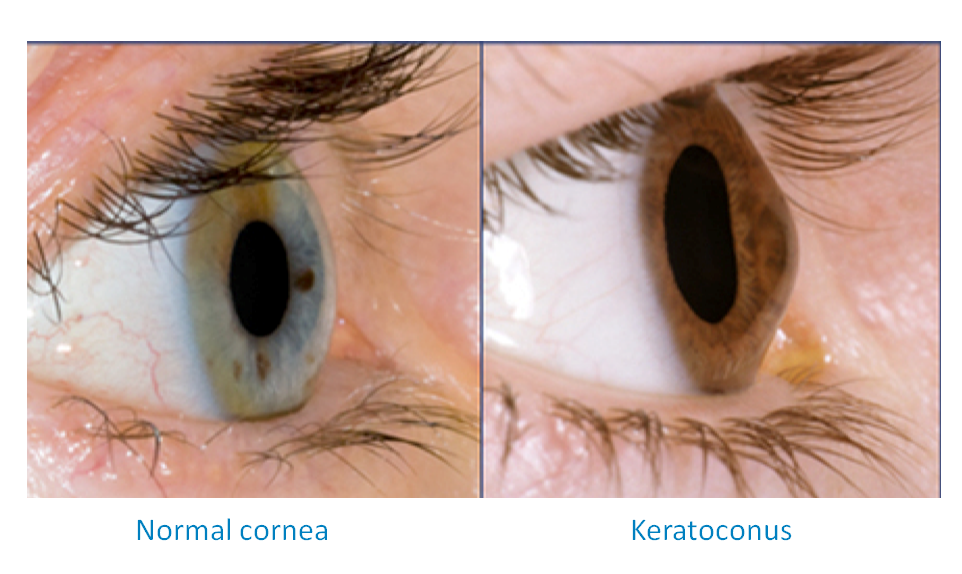This type of surgery performs one of the best surgeons in the world, prof. Dr Pavel Rozsival, who has more than 30 years of surgical experience.
The term CORNEAL ECTASIA, that includes keratoconus, comprises a group of corneal disorders characterized by weakness of the corneal structure and its thinning, leading to its protrusion (bulging out) which is called “conus” and to irregular astigmatism. These changes are progressive and lead to decreasing of the vision, decreasing of contact lens tolerance, and to complete intolerance and inability of “keeping the contact lens on the eye”. The threat of the final stage of thinning is the perforation (“opening”) of cornea and corneal transplantation is inevitable. The most common inborn ectasias are keratoconus and pellucid marginal degeneration, and acquired are post-lasik ectasia, post inflammatory, bullous keratopathy and other conditions of the softening of cornea. What is common to all of them is reduced biomechanical power because of reduced interfibrillar bonds, that are weakening in mentioned conditions.

New concept in treating these conditions is CORNEAL CROSS LINKING – which presents non-surgical procedure that manages halting of corneal degradation.
INDICATIONS for CXL:
– corneal ectasia, congenital and acquired
– keratoconus
– pellucid marginal degeneration
– iatrogenic keratectasia (post-lasik, pseudophakic keratopathy following inadequate cataract surgery) with prognostic projection toward corneal transplantation. It is best when intervention is performed in beginning stages, with pachymetric value greater than 400 microns of corneal thickness.
Yet, today we have capabilities to save corneas thinner than that from corneal transplantation.
Procedure is in clinical practice since the end of the nineties of the last century.
There are no changes in values of intraocular pressure during the procedure. Fitting of the special keratoconus contact lens follows after re-epithelization and recovering of cornea process.
AIM OF THE PROCEDURE is achieving biomechanical stabilization of cornea and halting of the progression of the disease to prevent the need for transplantation. This is a therapeutic procedure in conditions of progressive thinning of the cornea (ectasia), stimulating the genesis of additional chemical bonds within corneal stroma by strictly localized photopolymerization with maximum protection for surrounding tissues.
The procedure consists of homogenous illumination of corneal tissue (UVA 370nm) saturated with riboflavin solution (vitamin B2), by which are stimulated biochemical mechanisms for strengthening and creating new covalent bonds between collagen fibrils (increase of biomechanical power).
The procedure is painless and safe. Applied corneal anaesthesia is with drops.
THE EFFECT IS LOCALIZED AT ANTERIOR PART OF CORNEA.
TWO MAJOR GOALS IN TREATING CORNEAL ECTASIA ARE:
-Restoration of structural integrity of cornea, with corneal collagen cross-linking (CCL)
-Restoration of visual acuity, which is achieved by special contact lens.
Today, we have possibilities of fitting customized special lenses for this deformed cornea. Rose K2, Soft K and scleral contact lenses which are applied after completion of cross- linking procedure.
There is a possibility of application of refractive procedures, based on assessment of eye condition:
Laser or implantation of intraocular lens.
Combining these two methods of treatment and by correction of special lens for ectatic cornea, we are managing fantastic results in treatment, with complete rehabilitation of visual function, which explains the video story at the bottom of the page.
WHAT WAS OBSERVED AFTER CORNEAL CROSS LINKING APPLICATION?
-
Cessation of progression of ectasia
-
Decrease of regression
-
Improvement of contact lens tolerance
-
Fall of the maximal keratometric value
-
Slight flattening of cornea up to 2D astigmatism
-
Slight improvement of uncorrected visual acuity